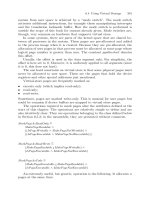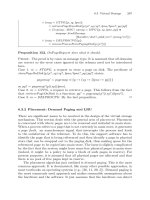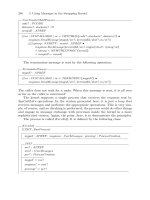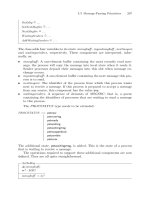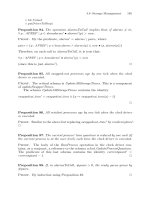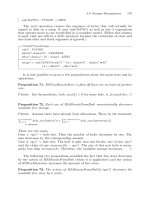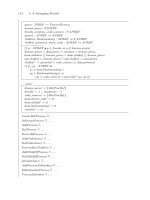Formal Models of Operating System Kernels phần 4 pot
Bạn đang xem bản rút gọn của tài liệu. Xem và tải ngay bản đầy đủ của tài liệu tại đây (273.09 KB, 32 trang )
4.6 Storage Management 153
codeToPSUs : PCODE → MEM
The next operation creates the sequence of bytes that will actually be
copied to disk on a swap. It uses codeToPSUs as well as two λ expressions
that operate more as one would find in a complete model. (When this schema
is used, that use will be a little incorrect because the extraction of start and
size from data and stack segments is ignored.)
CreateProcessImage
code ?:PCODE
stkstrt?, datastrt?:ADDRESS
stksz?, datasz ?:N
1
; image!:MEM
image!=codeToPSUs(code?)
(λ i : datastrt? datasz ? • 0)
(λ i : stkstrt? stksz? • 0)
It is now possible to prove a few propositions about the main store and its
operations.
Proposition 71. RSCanAllocateStore is false iff there are no holes of positive
size.
Proof. By the predicate, hole
size(h) > 0 for some hole, h,inranholes. ✷
Proposition 72. Each use of RSAllocateFromHole monotonically decreases
available free storage.
Proof. Assume there have already been allocations. Then, by the invariant:
i=#holes
i=1
hole size(holes(i)) +
j =#usermem
j =1
hole size(usermem(j ))
=#mem
There are two cases.
Case 1. rqsz? = hole size. Then the number of holes decreases by one. The
sum decreases by the corresponding amount.
Case 2. rqsz? < hole size. The hole is split into two blocks, one of size rqsz?
and the other of size memsize(h) − rqsz ?. The size of this new hole is neces-
sarily less than memsize(h). Therefore, the available storage decreases. ✷
The following two propositions establish the fact that free store decreases
by the action of RSAllocateFromHole (when it is applicable) and the action
of RSFreeMainstore increases the amount of free store.
Proposition 73. The action of RSAllocateFromHole[k/rqsz ?] decreases the
available free store by k units.
154 4 A Swapping Kernel
Proof. Again, without loss of generality, assume there have already been
allocations. Then, by the invariant:
i=#holes
i=1
hole size(holes(i)) +
j =#usermem
j =1
hole size(usermem(j )) = #mem
If k units are allocated from free store, it follows that #mem
is given by:
i=#holes
i=1
hole size(holes(i)) − k +
j =#usermem
j =1
hole size(usermem(j )) + k =
i=#holes
i=1
hole size(holes
(i)) +
j =#usermem
j =1
hole size(usermem
(j ))
✷
Proposition 74. The action of RSFreeMainstore[k/sz?] increases the avail-
able free store by k units.
Proof. This is the converse of the last proposition.
Again, we use the same conjunct of the invariant:
i=#holes
i=1
hole size(holes(i)) +
j =#usermem
j =1
hole size(usermem(j )) = #mem
If k units are returned to free store, it follows that #mem
is given by:
i=#holes
i=1
hole size(holes(i)) + k +
j =#usermem
j =1
hole size(usermem(j )) − k =
i=#holes
i=1
hole size(holes
(i)) +
j =#usermem
j =1
hole size(usermem
(j ))
✷
Proposition 75. If a hole is exactly the size of a request, it disappears from
thefreelist.
Proof. The predicate of RSAllocateFromHole states that
room left in hole(rqsz ?, h)=0∧
ran usermem
= ran usermem \{mspec!}
Since h = mspec!, ran usermem
=ranusermem \{h},soh ∈ ran usermem
. ✷
Proposition 76. If a hole is larger than that requested, it is split into two
and the smaller block is returned to the free list.
4.6 Storage Management 155
Proof. The predicate of RSAllocateFromHole states that:
mspec!=(la, rqsz !) ∧
holes
=(holes
−
{h})
mkrmemspec(nextblock(mspec!), hsz)
where hsz = memsize(h) − rqsz?andnextblock yields the index of the start
of the next block: nextblock(mkrmemspec(strt, sz )) = strt + sz.
Since hsz is the size of the block added to holes and hsz = memsize(h) −
rqsz?andhsz > 0 (by the predicate), it follows that:
memsize(mkrmemspec(nextblock(mspec!), hsz)) < memsize(h)
✷
Proposition 77. If all holes have size < rqsz ?, RSAllocateFromHole cannot
allocate any store.
Proof. Let rqsz?=n and let n be larger than the greatest block size. Then
room
left in hole(rqsz?, h) < 0 for all h. This falsifies the predicate of the
schema. ✷
Proposition 78. If the allocating hole is ≥ rqsz?, the hole is split into two
parts: one of size = rqsz ?, the other of size, s, s ≥ 0.
Proof. There are two cases to consider, given RSAllocateFromHole’s predi-
cate:
1. memsize(h)=rqsz?, and mspec is of size rqsz?, so s = 0 (the smaller part
is of zero length);
2. memsize(h)=rqsz?andmspec is of size rqsz?, so memsize(h) − rqsz?is
the size of one part and s > 0 is the size of the other.
✷
The next proposition establishes the fact that merging adjacent free blocks
(holes) decreases the number of blocks in free store.
Proposition 79. MergeAdjacentBlocks ⇒ # ran holes
< # ran holes.
Proof. For the purposes of this proposition, the critical line is:
holes
=[((holes
−
{h
1
})
−
{h
2
})
mergememholes(h
1
, h
2
)]
So:
156 4 A Swapping Kernel
# ran holes
= # ran[((holes
−
{h
1
})
−
{h
2
})
mergememholes(h
1
, h
2
)]
= # ran((holes
−
{h
1
})
−
{h
2
})+#ranmergememholes(h
1
, h
2
)
= # ran((holes \{h
1
}) \{h
2
})+#ranmergememholes(h
1
, h
2
)
= # ran((holes \{h
1
}) \{h
2
})+1
= (#(ran holes \{h
1
}) − 1) + 1
= (#(ran holes) − 2) + 1
= # ran holes − 1
≤ # ran holes
✷
If the free blocks are reduced in number, what happens to their size? The
following proposition establishes the fact that the merging of adjacent free
blocks creates a single new block whose size is the sum of all of the merged
blocks.
Proposition 80. If h
1
and h
2
are adjacent holes in the store of size n
1
and
n
2
, respectively, then MergeAdjacentHoles implies that there exists a hole of
size n
1
+ n
2
.
Proof. Since h
1
and h
2
are adjacent, they can be merged. The definition of
mergememholes is:
∀ h
1
, h
2
: MEMDESC •
(lower
hole addr(h
1
, h
2
), memsize(h
1
)+memsize(h
2
))
The size of the merged hole is therefore memsize(h
1
)+memsize(h
2
). Letting
memsize(h
1
)=n
1
and memsize(h
2
)=n
2
, it is clear, by the definition of
mergememholes, that:
memsize(h
1
)+memsize(h
2
)=n
1
+ n
2
✷
It is clear that we do not want operations on the free store to affect the
store allocated to processes. The following proposition assures us that nothing
happens to user store when adjacent blocks of free store are merged.
Proposition 81. MergeAdjacentHoles leaves user store invariant.
Proof. The predicate does not alter usermem. ✷
Proposition 82. If h
1
and h
2
are adjacent holes and MergeAdjacentHoles is
applied to merge them, then # ran holes
=#ran holes − 1.
Proof. By Proposition 79. ✷
4.6 Storage Management 157
Proposition 83. The predicate of schema FreeMainstoreBlock implies that
# ran holes
> # ran holes and that # ran usermem
< # ran usermem.
Proof. By the definition of FreeMainstoreBlock:
holes
= holes
mkrmemspec(start, sz?)
so:
# ran holes
= # ran(holes
mkrmemspec(start, sz?))
= # ran holes + # ran(mkrmemspec(start, sz?))
= # ran holes +1
and so, # ran holes
> ran holes.
Now,
# ran usermem
= # ran(usermem
−
{mkrmemspec(start, sz ?)})
= #(ran usermem \{mkrmemspec(start, sz ?)})
= # ran usermem − 1
Therefore # ran usermem
< #ranusermem. ✷
Proposition 84. If n calls to the allocator request k units of store, followed
immediately by n calls to RSFreeMainStore, each returning k units of store,
return the store to its original state.
Proof. We need to show that the sizes of usermem and holes are unchanged.
By Proposition 73, the size of the store after the n allocations is:
i=#holes
i=1
hole size(holes(i)) − nk+
j =#usermem
j =1
hole size(usermem(j )) + nk =
i=#holes
i=1
hole size(holes
(i))+
j =#usermem
j =1
hole size(usermem
(j ))
while that after the n deallocations is, by Proposition 74:
i=#holes
i=1
hole size(holes
(i)) + nk+
j =#usermem
j =1
hole size(usermem
(j )) − nk =
i=#holes
i=1
hole size(holes
(i))+
j =#usermem
j =1
hole size(usermem
(j )) =
i=#holes
i=1
hole size(holes(i))+
j =#usermem
j =1
hole size(usermem(j ))
✷
158 4 A Swapping Kernel
Proposition 85. #image!=#code + stksz?+datasz?.
Proof. Note that codeToPSUs is of type PCODE → MEM ,so#code =
#codeToPSUs since MEM = seq PSU .
Now
#image!=
#(codeToPSU (code?)
(λ i :1 datasz ? • 0)
(λ i :1 stksz ? • 0))
=#(codeToPSU (code?) + #(λ i :1 datasz? • 0) + #(λ i :1 stksz ? • 0))
=#code +#datasz ?+#stksz?
✷
The real store on the hardware is represented by a unique instance of
SharedMainStore.Thisisastorethatreferstotherealstorebutwhoseop-
erations are protected by locks. All that is required is that the operations be
indivisible. The class is defined as follows:
SharedMainStore
(INIT , CanAllocateInStore, AllocateFromHole,
AllocateFromUsed, FreeMainStore, CopyMainStore, WriteMainStore)
lms : LINERAMAINSTORE
lck : Lock
INIT
lms.INIT
CanAllocateInStore =
lck.Lock
o
9
lms.RSCanAllocateInStore
o
9
lms.Unlock
AllocateFromHole =
lck.Lock
o
9
RSAllocateFromHole
o
9
lck.Unlock
AllocateFromUsed =
lck.Lock
o
9
RMAllocateFromUsed
o
9
lck.Unlock
FreeMainStore =
lck.Lock
o
9
RSFreeMainStore
o
9
lck.Unlock
CopyMainStore
=
lck.Lock
o
9
RSCopyMainStoreSegment
o
9
lck.Unlock
WriteMainStore =
lck.Lock
o
9
RSWriteMainStoreSegment
o
9
lck.Unlock
4.6.1 Swap Disk
This section contains a high-level model of the swap disk. The swap disk is
where swapped process images are stored. It is assumed to be more or less
infinite in size.
4.6 Storage Management 159
Communication with the swap disk is in terms of a buffer containing an
operation code. The codes are defined as:
SWAPRQMSG ::= NULLSWAP
| SWAPOUT PREF × ADDRESS × ADDRESS
| SWAPIN PREF × ADDRESS
| NEWSPROC PREF × MEM
| DELSPROC PREF
The NULLSWAP operation is a no-operation: if the opcode is this value, the
swap disk should do nothing. A SWAPOUT code specifies the identifier of the
process whose store is to be swapped out and the start and end addresses of
the segment to be written to disk. A SWAPIN code requests the disk to read
a segment and transfer it to main store. A NEWSPROC specifies that the
store represented by MEM is to be stored on disk and that PREF denotes
a newly created process that cannot be allocated in store at present. Finally,
the DELSPROC code indicates that the named process is to be removed
completely from the disk (it should be removed from the swap disk’s index).
The buffer that supplies information to the swap disk is SwapRQBuffer.
A semaphore is used to provide synchronisation between the swapper process
and the swap disk process.
The buffer is modelled by a class and is defined as follows:
SwapRQBuffer
(INIT , Write, Read )
mutex, msgsema : Semaphore
buff : SWAPRQMSG
INIT
mt?:Semaphore
ptab?:ProcessTable
sched?:LowLevelScheduler
lck?:Lock
mutex
= mt?
(∃ iv : Z | iv =1•
msgsema
= Semaphore.Init[iv/iv ?, ptab?/pt?,
sched?/sch?, lck?/lk?])
buff
= NULLSWAP
Write =
Read
=
This class has two main operations, one for reading a request buffer and one for
writing a reply buffer. The buffers are protected by semaphores. Semaphores
160 4 A Swapping Kernel
are correct at this level because the code that calls Read and Write is executed
by system processes, not by kernel primitives.
The Write operation is simple and defined as:
Write
∆(buff )
rq ?:SWAPRQMSG
msgsema.Wait ∧ buff
= rq ? ∧ msgsema.Signal
The Read operation is also simple:
Read
rq !:SWAPRQMSG
mutex.Wait
msgsema.Wait
mutex.Signal
rq !=buff
buff
= NULLSWAP
mutex.Wait
msgsema.Signal
mutex.Signal
Readers should note that the above buffer protocol is asymmetric. If a
reader is already reading and a writer is waiting to write, the code will permit
other readers to perform reads before the writer is permitted to write new
data. In this particular case, this is permissible because there is exactly one
reader, the swap-disk driver, and two writers, the swapper and store manager
processes.
The driver process for the swap disk is relatively simple. Its basic tasks
are to store process images and to retrieve them again when required. The
images are indexed by process reference or identifier (APREF ). Only “gen-
uine” processes can have their images swapped out, and thus only processes
whose reference is an element of APREF. The image stored on the swap disk
is a copy of a contiguous segment of main store, so the objects stored on the
swap disk are elements of type MEM (sequences of PSU ).
The swap-disk model uses a finite partial map to represent the disk storage
and index. Two semaphores are used, one to synchronise with the device
driver that passes requests to the disk-controller process and a semaphore to
synchronise with the storage management module. The second semaphore is
used to signal the fact that the transfer has been completed; if this semaphore
were not included, there is the risk that the storage management module
would assume that a transaction had been completed, while, in fact, it had
not.
4.6 Storage Management 161
Requests to the swap disk process are placed in the SwapRQBuffer.This
is a piece of shared storage and is guarded by its own semaphore.
The read and write operations are to main store. Main store is, of course,
shared, so locking is used to prevent interrupts from occurring while read and
write operations are under way. It would be natural to assume that, since
this is the only process running at the time reads and writes are performed,
main store would, in effect, belong to this process. However, an interrupt
could cause another process to be resumed and that process might interact
with this one. This is, it must be admitted, a bit unlikely, but it is safer to
use the scheme employed here. The alternative is to guard main store with
a semaphore. This is not an option here because the storage-management
software is implemented as a module, not a process.
The driver uses a semaphore to synchronise with the swapper process
for reading the SwapRQBuffer. This is the semaphore called devsema in the
definition of the class. It also uses a second semaphore, called donesema,which
is used to indicate the fact that the disk read has been completed (the reason
for this will become clear below).
The class that follows is, in fact, a combination of the process that performs
the copy to and from disk and the disk itself. The reason for this is that the
disk image is as important a part of the model as the operations to read and
write the byte sequences and process references.
The swap disk’s driver process is defined as:
SWAPDISKDriverProcess
(INIT , RunProcess)
devsema : Semaphore
donesema : Semaphore
dmem : APREF → MEM
sms : SharedMainStore
rqs : SwapRqBuffer
INIT
dsma?:Semaphore
devsemaphore?:Semaphore
rqbuff ?:SwapRqBuffer
store?:SharedMainStore
donesema
= dsma?
devsema
= devsemaphore?
dom dmem
= ∅
rqs
= rqbuff ?
sms
= store?
162 4 A Swapping Kernel
writeProcessStoreToDisk =
readProcessStoreFromDisk =
deleteProcessFromDisk =
sleepDriver =
handleRequest =
RunProcess =
Even though this is a system process, the main store is locked when read and
write operations are performed. This is because arbitrary interrupts might
occur when these operations are performed; even though it is controlled by
a semaphore (so processes cannot interfere with any operation inside it), the
body of critical regions is still open to interrupts. The lock is used as an
additional safety measure, even though it is not particularly likely that an
interrupt would interfere with the store in question.
writeProcessStoreToDisk
∆(dmem)
p?:APREF
ms?:MEM
dmem
= dmem ⊕{p? → ms?}
readProcessStoreFromDisk
p?:APREF
ms!:MEM
ms!=dmem(p?)
deleteProcessFromDisk
∆(dmem)
p?:APREF
dmem
= {p?}
−
dmem
When the driver is not performing any operations, it waits on its devsema.
ThedriverisawakenedupbyaSignal on devsema. When the request has been
handled, the Wait operation is performed to block the driver. This is a safe
and somewhat standard way to suspend a device process.
sleepDriver = devsema.Wait
The remaining operation is the one that handles requests. When the device
process has the semaphore, it reads the data in the request block; in particular,
4.6 Storage Management 163
it examines the operation. The operation requested is used to perform the
appropriate operation. The schema modelling this is:
handleRequest
rq ?:SWAPRQMSG
(∃ p : APREF ; start, end : ADDRESS ; mem : MEM •
rq ?=SWAPOUT p, start, end
∧ sms.CopyMainStore[start/start?, end/end?, mem/mseg!]
∧ writeProcessStoreToDisk [p/p?, mem/ms?])
∨ (∃ p : APREF ; ldpt : ADDRESS ; mem : MEM •
rq ?=SWAPIN p, ldpt
∧ readProcessStoreFromDisk[p/p?, mem/ms!]
∧ sms.WriteMainStore[ldpt/loadpoint?, mem/mseg?]
∧ donesema.Signal)
∨ (∃ p : APREF •
rq ?=DELSPROC p ∧ deleteProcessFromDisk[p/p?])
∨ (∃ p : APREF ; img : MEM •
rq ?=NEWSPROC p, img
∧ writeProcessStoreToDisk [p/p?, img/img?])
The semaphore, donesema, is used to synchronise with the swapper process
directly. It is used to ensure that the write request has completed before the
swapper process updates the storage tables associated with the process that
is being swapped. This is to ensure consistency.
The main loop for the swap disk process is as follows. The reader should
note the ad hoc use of a universal quantifier to model an infinite loop:
RunProcess =
∀ i :1 ∞•
sleepDriver
o
9
(∃ rq : SWAPRQMSG •
rqs .ReadRequest[rq /rq !]
∧ (rq = NULLSWAP ∧ sleepDriver)
∨ (handleRequest ∧ sleepDriver))
Proposition 86. p? ∈ dom dmem and dmem
= dmem = ⊕{p? → ms?}
implies that p? ∈ dom dmem
. In addition, if p? ∈ dom dmem and dmem
=
dmem ⊕{p? → ms?}, this implies that p? ∈ dom dmem
.
Proof. Both parts are a consequence of the definition of ⊕: f ⊕ g(x)=
g(x )ifx ∈ dom g and f (x ) otherwise. ✷
4.6.2 Swapper
This subsection is about the process swapper. In fact, the swapper is better
described as a storage-management module. The software is a module because
164 4 A Swapping Kernel
it implements a set of tables describing the state of each user process’ storage.
In particular, the module contains tables recording the identifiers of those pro-
cesses that are currently swapped out to disk (swapped
out)andthetimethat
each process has spent out of main store on the swap disk (swappedout
time).
Swapping, in this kernel, is based on the time processes have spent swapped
out, so these two tables are of particular importance. However, the time a
process has been resident in main store is significant and is used to determine
which process to swap out when its store is required to hold a process that
is being swapped in from disk. The time each process resides in main store is
recorded in the residency
time table.
The operations on the class ProcessStorageDescr are composed of struc-
tures that record the time each (user) process has resided in main store and
the time it has resided on disk. Marking operations are also provided so that
the system can keep track of which processes are in store and which are not.
The remaining operations are concerned with housekeeping and which deter-
mining which processes to swap in and out of main store.
It was decided (somewhat unfairly) that main-store residency time would
include the time processes spend in queues of various sorts. This has the
unfortunate consequence that a process could be swapped in, immediately
make a device request and block; as soon as the request is serviced and the
process is readied, it is swapped out again. However, other schemes are very
much more complicated to model and therefore to implement.
The class is defined as follows:
ProcessStorageDescrs
(INIT , MakeInStoreProcessSwappable, MakeProcessOnDiskSwappable,
UpdateAllStorageTimes, MarkAsSwappedOut, MarkAsInStore,
ClearProcessResidencyTime,
ClearSwappedOutTime, IsSwappedOut, SetProcessStartResidencyTime,
SetProcessStartSwappedOutTime, UpdateProcessStoreInfo,
RemoveProcessStoreInfo,
AddProcessStoreInfo,
ProcessStoreSize, ReadyProcessChildren,
CodeOwnerSwappedIn, ReadyProcessChildren, NextProcessToSwapIn,
BlockProcessChildren , HaveSwapoutCandidate, FindSwapoutCandidate)
proctab : ProcessTable
sched : LowLevelScheduler
swapped out : F APREF
residencytime : APREF → TIME
swappedout time : APREF → TIME
swapped out ⊆ dom pmem ∧ swapped out ⊆ dom pmemsize
dom swappedout time = swapped out
dom residencytime ∩ swapped out = ∅
4.6 Storage Management 165
INIT
pt?:ProcessTable
sch?:LowLevelScheduler
proctab
= pt? ∧ sched
= sch?
swapped out
= ∅ ∧ dom residencytime
= ∅
dom swappedout time
= ∅
MakeInStoreProcessSwappable =
MakeProcessOnDiskSwappable =
UpdateAllStorageTimes =
MarkAsSwappedOut =
MarkAsInStore =
ClearProcessResidencyTime =
ClearSwappedOutTime =
IsSwappedOut =
SetProcessStartResidencyTime =
SetProcessStartSwappedOutTime =
AddProcessStoreInfo =
UpdateProcessStoreInfo
=
RemoveProcessStoreInfo =
ProcessStoreSize =
CodeOwnerSwappedIn =
BlockProcessChildren =
ReadyProcessChildren =
NextProcessToSwapIn =
HaveSwapoutCandidate =
FindSwapoutCandidate
=
As can be seen, the class has a rather large number of operations.
The following schema defines the operation that makes a process swap-
pable. It does this by setting its main-store residency time to 0.
MakeInStoreProcessSwappable
pid?:APREF
residencytime
= residencytime ⊕{pid? → 0}
Processes can be created on disk when there is insufficient main store avail-
able. As user processes, they can be made swappable. The following operation
166 4 A Swapping Kernel
does this. It just sets the swapped-out time to 0 and adds the process reference
to the set of swapped-out processes.
MakeProcessOnDiskSwappable
pid?:AREF
swappedout
time
= swappedout time ⊕{pid? → 0}
swapped out
= swapped out ∪{pid?}
The management module interacts with the clock. On every clock tick,
the time that each process has been main-store and swap-disk resident is
incremented by one tick (actually by the amount of time represented by a
single tick). The following schema defines this operation:
UpdateAllStorageTimes
∆(swappedout time, residencytime)
(∀ p : APREF | p ∈ dom residencytime •
residencytime
= residencytime ⊕{p → residencytime(p)+1})
(∀ p : APREF | p ∈ dom swappedout time •
swappedout time
= swappedout time⊕
{p → swappedout time(p)+1})
When a process is swapped out to disk, it must be marked as being no
longer in main store. The following schema defines this operation:
MarkAsSwappedOut
∆(swapped out)
p?:APREF
swapped out
= swapped out ∪{p?}
Conversely, when a process is copied into main store, the management
software needs to make a record of this fact. The operation MarkAsInStore
performs this marking and is defined as:
MarkAsInStore
∆(swapped out)
p?:APREF
swapped out
= swapped out \{p?}
Note that the marking is modelled as a simple set operation. The assumption
is that a process that is not marked as swapped out is resident in main store.
When a process enters main store, or terminates, its residency time has to
be cleared:
4.6 Storage Management 167
ClearProcessResidencyTime
∆(residencytime)
p?:APREF
residencytime
= residencytime ⊕{p? → 0}
Similarly, when a process is swapped out, or terminates, the time that it
has spent on disk has to be set to zero:
ClearSwappedOutTime
∆(swappedout time)
p?:APREF
swappedout time
= swappedout time ⊕{p? → 0}
The following pair of schemata define operations to set the start times for
main-store and swap-disk residency. The idea is that the actual time is set,
rather than some number of clock ticks.
SetProcessStartResidencyTime
∆(residencytime)
p?:APREF
t?:TIME
residencytime
= residencytime ⊕{p? → t?}
SetProcessStartSwappedOutTime
∆(swappedout time)
p?:APREF
t?:TIME
swappedout time
= swappedout time ⊕{p? → t?}
The following predicate is used to determine whether a process is on disk.
IsSwappedOut
p?:APREF
p? ∈ swapped
out
When a process is created, entries in the storage-management tables must
be created. The storage descriptor describing the process’ main-store region
is set in the process’ descriptor.
AddProcessStoreInfo =
(∃ pd : ProcessDescr •
proctab.DescrOfProcess[p?/pid?, pd /pd !]
∧ pd .SetStoreDescr[mdesc?/newmem?])
168 4 A Swapping Kernel
The following operation updates the storage descriptor should a process
be relocated when swapped into main store. The storage descriptor input to
this operation (mdesc?) need not be the same as the one already stored. This
is because the swap-in operation stores the process image in the first available
hole in main store that is of sufficient size.
UpdateProcessStoreInfo =
(∃ pd : ProcessDescr •
proctab.DescrOfProcess[p?/pid?, pd /pd !]
pd .SetStoreDescr[mdesc?/newmem?])
The following operation removes a process from the storage-management
module’s tables. It also removes the storage descriptor from the process’ de-
scriptor in the process table.
RemoveProcessStoreInfo
∆(residencytime, swappedout time)
p?:APREF
residencytime
= {p?}
−
residencytime
swappedout time
= {p?}
−
swappedout time
(∃ md : MEMDESC ; pd : ProcessDescr •
md =(0, 0)
∧ proctab.DescrOfProcess[p?/pid?, pd /pd !]
∧ pd .SetStoreDescr[md/newmem?])
The next schema defines an operation that computes the size of the storage
occupied by a process:
ProcessStoreSize =
(∃ pd : ProcessDescr •
proctab.DescrOfProcess[p?/pid?, pd /pd !]
pd .StoreSize)
The next few schemata operate on the children of a process. When a pro-
cess blocks, its children, according to this process model, must also be blocked.
The reason for this is that the children of a process share its code. Child pro-
cesses do not copy their parent’s code and become a totally independent unit.
The reason for this is clear: if child processes were to copy their parent’s code,
the demand upon store would increase and this would decrease the number
of processes that could be maintained in main store at any one time. The
advantage to independent storage of code is that processes can be swapped
out more easily. However, the consumption of main store is considered, in this
design at least, to be more important than the ease of swapping. Therefore,
the swapping rules for this kernel are somewhat more complex than for some
other possible designs.
The process model (such as it is) for this kernel is somewhat similar to
that used by Unix: processes can create child processes (and child processes
4.6 Storage Management 169
can create child processes up to some limit on depth
3
. Child processes share
their parent’s code but have their own private stack and data storage. When
a parent is swapped out, its code is also swapped out (which makes an already
complex swapping mechanism a little simpler). Because the parent process’
code is swapped out, child processes have no code to execute. It is, therefore,
necessary to unready the children of a swapped-out parent. The following
schema defines this operation.
The schema named BlockProcessChildren blocks the descendant processes
of a given parent. The complete set of descendants is represented by the
transitive closure of the childof relation; the complete set of descendants of
a given process are represented by childof
+
(|{p?}|) for any process identifier
p?. In BlockProcessChildren, ps is the set of descendants of p? (should they
exist). The operation then adds the processes in ps to the blockswaiting set
(which is used to denote those processes that are blocked because the code
they execute has been swapped out); and it sets their status to pstwaiting.
BlockProcessChildren
p?:APREF
∃ ps, offspring : F APREF ; pd : ProcessDescr •
proctab.DescrOfProcess[p?/pid?, pd /pd !]
∧ proctab.AllDescendants[p?/parent, offspring/descs!]
∧ pd .BlocksProcesses[ps/bw!]
∧ (∀ p : APREF | p ∈ ps ∪ offspring •
(∃ pd
1
: ProcessDescr •
proctab.DescrOfProcess[p/pid?, pd
1
/pd !]
∧ pd
1
.SetProcessStatusToWaiting)
∧ sched.MakeUnready[p/pid ?])
The schema could be simplified.
When a parent is returned to main store, its children can be readied (i.e.,
added to the ready queue). The following schema defines this operation in a
fairly obvious fashion.
First, the identifiers of all processes that become blocked when the pro-
cess denoted by parent ? is blocked are determined by pd .BlocksProcesses.
Next, identifiers of all the descendants of the process are determined by
AlDescendants. Next, each of the identifiers in the union of these two sets
is marked as being present in store and then added to the ready queue so that
it can be scheduled.
3
The actual limit is imposed by the maximum number of entries in the process
table. This fact is a clear problem for a kernel’s security: a malicious process could
deliberately create child processes.
170 4 A Swapping Kernel
ReadyProcessChildren
∆(swapped out)
parent?:APREF
∃ pd : ProcessDescr; bw, offspring : F APREF •
proctab.DescrOfProcess[parent?/pid?, pd /pd !]
∧ pd .BlocksProcesses[bw/bw !]
∧ proctab.AllDescendants[offspring/descs!]
∧ (∀ c : APREF | c ∈ bw ∪ offspring •
(∃ cdesc : ProcessDescr •
proctab.DescrOfProcess[c/pid?, cdesc/pd !]
∧ MarkAsInStore[c/p?] ∧ sched.MakeReady[c/pid?]))
What if a child is waiting for a device request completion? It cannot sud-
denly be stopped. A quick and totally horrid solution is to require that all
children be in the ready queue when the swap occurs.
The reader is invited to find better alternatives and to specify them in an
appropriate notation.
Proposition 87. For any parent process, p,
BlockProcessChildren ⇒ (∀ p
1
: APREF | childof (p
1
, p) • p ∈ ran userqueue )
Proof. The predicate of BlockProcessChildren contains an instance of
MakeUnready inside the scope of the universal quantifier. The universal
quantifier ranges over all possible descendants of input process p?. Since
MakeUnready removes its argument from the ready queue, the result is proved.
✷
Proposition 88. If there are n processes in the ready queue at the user level
and process ϕ has p descendants, then after BlockProcessChildren, the length
of the user-level queue will be n − 1.
Proof. Without loss of generality, it can be assumed that all descendants of
process ϕ, and all processes that it blocks, have user-level priority. Let blocks =
ps ∪ offspring and #blocks = p. By the predicate of the schema, it follows
that ∀ p ∈ blocks • MakeUnready[p/pid?], so there must be p applications of
MakeUnready to blocks. By Proposition 53:
#readyqueues
(userqueue)=#readyqueues(userqueue) − p
✷
Proposition 89. If there are n processes in the ready queue at the user level
and process ϕ has p descendants, then after ReadyProcessChildren, the length
of the user-level queue will be n + p.
4.6 Storage Management 171
Proof. Again, without loss of generality, it can be assumed that all descen-
dants of process ϕ, and all processes that it blocks, have user-level priority.
Again, let blocks = bw ∪ offspring and let #blocks = p. By reasoning similar
to that in the last proposition:
#readyqueues
(userqueue)=#readyqueues(userqueue)+p
✷
The following is an immediate consequence of the last proposition.
Corollary 7. Operation ReadyProcessChildren changes the state of all pro-
cesses affected by it to pstready.
Proposition 90. BlockProcessChildren
o
9
ScheduleNext implies that currentp
is not a descendant of the ancestor of the process just blocked.
Proof. This requires the proof of the following lemma.
Lemma 16. For any process, p, BlockProcessChildren implies that there are
no children of p in the ready queue after the operation completes.
Proof. In the predicate of schema BlockProcessChildren, ps represents the
descendants of process p. From this, using the predicate, it can be seen that
MakeUnready[p/pid?] for all p ∈ ps implies p ∈ ran userqueue. In other
words, the process, p, is removed from the ready queue by the operation
MakeUnready. Therefore, there are no children of p in the ready queue. ✷
By Lemma 16, no child of p can be in the ready queue. More specifically,
that head(tail userqueue)cannotbeachildofp. This establishes the desired
result. ✷
The following schema defines a predicate that is true when a process that
owns its code is swapped into main store. Code owners are either independent
processes or are parents.
CodeOwnerSwappedIn
p?:APREF
(∃ p
1
: APREF ; pd : ProcessDescr •
proctab.DescrOfProcess[p
1
/pid?, pd /pd !]
∧ (pd .SharesCodeWith[p
1
/pid?]
∨ pd .HasChild[p
1
/ch?])
∧ pd .IsCodeOwner
∧ p
1
∈ swapped out)
The next schema is another predicate. This time, it is one that determines
which process next to swap into main store. The candidate is the process that
172 4 A Swapping Kernel
has been swapped out for the longest time. The identifier of the process (pid!),
together with the amount of store it requires (sz!), is returned.
NextProcessToSwapIn
pid!:APREF
sz!:N
(∃ p : APREF | p ∈ swapped out •
swappedout time(p)=max (ran swappedout time) ∧
pid!=p ∧
sz!=pmemsize(p))
Only user processes in the ready state can be swapped out. It is essential
that this condition be recorded in the model. Instead of stating it directly, a
less direct way is preferred. It is expressed by the following constant definition:
illegalswapstatus : PROCSTATUS
illegalswapstatus = {pstrunning, pstwaiting, pstswappedout,
pstnew, pstterm, pstzombie}
Again, the following schema defines a predicate. This predicate is true
when the storage-management module has a candidate process to swap out
to disk.
HaveSwapoutCandidate
rqsz ?:N
(∃ pd : ProcessDescr; st : PROCSTATUS; k : PROCESSKIND; sz : N;
tm : TIME; tms : F TIME •
proctab.DescrOfProcess[p
1
/pid?, pd /pd !]
∧ pd .ProcessKind[k/knd!] ∧ k = ptsysproc ∧ k = ptdevproc
∧ pd .ProcessStatus[st/st!] ∧ st ∈ illegalswapstatus
∧ pd .StoreSize[sz /memsz !] ∧ sz ≥ rqsz ?
∧ pdescrs.ResidencyTime[tm/tm!] ∧ pdescrs.AllResidencyTimes[tms/tms!]
∧ tm = max tms
The swapout candidate is a user process that is in the ready queue (illegalstatus
is a set of state names that excludes pstready). The amount of store the can-
didate occupies must be at least the same as that requested for the incoming
process (this is represented by rqsz ?). The candidate must also have the great-
est main-store residency time. System and device processes do not appear in
any of the storage-management tables, so it is not possible for an attempt to
be made to swap one of them out.
4.6 Storage Management 173
The candidate process to be swapped out is located by the following op-
eration. It is, again, fairly straightforward. It locates a process that is not in
one of the “banned” states defined by illegalswapstatus. The process must not
be a device or system process; that is, it must be a user process. The victim
process must also occupy a storage region whose size is at least that required
(rqsz?) to fit the incoming process.
FindSwapoutCandidate
p?:APREF
cand !:APREF
rqsz ?:N
slot!:MEMDESC
(∃ p : APREF ; t : TIME | residencytime(p)=t •
p = p? ∧
pstatus(p) ∈ illegalswapstatus ∧
pkind(p) = ptsysproc ∧
pkind(p) = ptdevproc ∧
pmemsize(p) ≥ rqsz ? ∧
(∀ p
1
: APREF •
(p
1
= p ∧ p
1
= p?
∧ p
1
∈ dom residencytime ∧ t ≥ residencytime(p
1
))
⇒ p = cand ! ∧ pmem(p)=slot!))
A proposition can now be proved about the priority of swap-out candi-
dates.
Proposition 91. Only user-level processes that are ready to run can be
swapped out.
Proof. By the predicate of HaveSwapoutCandidate, the kind of process is
k,andk = sysproc ∧ k = devproc implies that k = userproc, so the process is
at the user level. By the condition that st ∈ illegalswapstatus,and
illegalswapstatus = {pstrunning, pstwaiting, pstswappedout, pstnew, pstterm}
it follows that the process can only be in the ready state (pstready). ✷
4.6.3 Clock Process
The clock process is an extremely important component of the system. As
has been seen, the clock is used to pre-empt user-level processes. In addition,
processes of all kinds can use the clock to suspend themselves for a specified
period of time; when that time has expired, the processes receive an “alarm”
call which wakes them up and places them on the ready queue. This first
organisation for the clock process is shown in Figure 4.2.
174 4 A Swapping Kernel
Clock
Process
Alarms
etc.
Processes waiting
for alarms
Clock
ISR
H/W Clock
Signal
Signal
Fig. 4.2. The clock process in relation to its interrupt and alarm requests.
ticklength : TIME
GenericISR
(INIT ,
OnInterrupt,
AfterProcessingInterrupt,
WakeDriver)
hw : HardwareRegisters
ptab : ProcessTable
driversema : Semaphore
sched : LowLevelScheduler
INIT
sema?:Semaphore
schd?:LowLevelScheduler
hwregs?:HardwareRegisters
proctb?:ProcessTable
ptab
= proctb?driversema
= sema?
hw
= hwregs?
sched
= schd?
OnInterrupt =
AfterProcessingInterrupt =
WakeDriver =
saveState
=
restoreState =
4.6 Storage Management 175
WakeDriver
driversema.Signal
When an interrupt occurs, SaveState is called to save the state. The schema
defines an operation that retrieves the current process’ descriptor from the
process table. Then, the contents of the hardware’s general registers are copied
from the hardware, as are the contents of the stack register, the instruction
pointer and the status word. The time quantum value is also copied and the
values set in the appropriate slots in the process descriptor.
The reader should note that there is a slight fiction in the saveState op-
eration. It concerns the instruction pointer. Clearly, as saveState executes,
the IP register will point to instructions in saveState, not in the code of the
current process (the process pointed to by currentp). The saveState operation
is called from ISRs. This implies that an interrupt has occurred and that the
hardware state has already been stored somewhere (certainly, the instruction
pointer must have been stored somewhere so that the ISR could execute). Be-
cause this model is at a relatively high level and because we are not assuming
any specific hardware, we can only assume that operations such as GetGPRegs
and GetIP can retrieve the general-purpose and instruction registers’ contents
from somewhere.
What has been done in the model is to abstract from all hardware. The
necessary operations have been provided, even though we are unable to define
anything other than the name and signature of the operations at this stage.
(In a refinement, these issues would, of necessity, be confronted and resolved.)
Once saveState has terminated, device-specific code is executed. Finally,
the operation to restore the hardware state is called to perform a context
switch.
The first part of the context switch is performed by saveState.Thisopera-
tion copies the hardware state, as represented by the programmable registers,
the instruction pointer and the status word, as well as the variable contain-
ing the process’ time quantum. (Non-user processes just have an arbitrary
value stored.) The state information is then copied into the outgoing process’
process descriptor.
saveState
(∃ cp : IPREF •
sched.CurrentProcess[cp/cp!]
(∃ pd : ProcessDescr •
ptab.DescrOfProcess[cp/pid?, pd /pd !]
∧ (∃ regs : GENREGSET ; stk : PSTACK; ip : N;
stat : STATUSWD; tq : TIME •
hw.GetGPRegs[regs /regs !]
∧ hw.GetStackReg[stk/stk !]
∧ hw.GetIP[ip/ip!]
176 4 A Swapping Kernel
∧ hw.GetStatWd[stat/stwd!]
∧ sched.GetTimeQuantum[tq/tquant!]
∧ pd .SetFullContext
[regs /pregs?, ip/pip?, stat/pstatwd?,
stk/pstack?, tq/ptq?])))
The current process referred to here is not necessarily the same as the one
referred to above. Basically, whatever is in currentp runs next. The reason for
this is that the scheduler might be called by the device-specific code that is
not defined here.
The code supplied for each specific device should be as short as possible.
It is a general principle that ISRs should be as fast as possible, preferably just
handing data to the associated driver process.
Once the device-specific code has been run, the state is restored. As noted
above, the actual state might be that of a process different from the one bound
to currentp when saveState executed. This is because the low-level scheduler
might have been called and currentp’s contents replaced by another value. The
operation for restoring state (of whatever process) is defined by the following
schema:
restoreState
(∃ cp : IPREF •
sched.CurrentProcess[cp/cp!]
∧ (∃ pd : ProcessDescr •
ptab.DescrOfProcess[cp/pid?, pd /pd !]
∧ (∃ regs : GENREGSET ; stk : PSTACK;
ip : N; stat : STATUSWD; tq : TIME •
pd .FullContext[regs /pregs!, ip/pip!, stat/pstatwd !,
stk/pstack!, tq/ptq!]
∧ hw.SetGPRegs[regs /regs ?]
∧ hw.SetStackReg[stk/stk ?]
∧ hw.SetStatWd[stat/stwd?]
∧ sched.SetTimeQuantum[tq/tquant?]
∧ hw.SetIP[ip/ip?])))
In this case, the various registers are all stored in known locations inside the
kernel (in the descriptor of the process that is to run next). The transfers are
moves to the hardware’s registers. The instruction pointer is the last to be set
(for obvious reasons).
These are the generic interrupt service routines. The first is called before
performing the interrupt-specific operations:
4.6 Storage Management 177
OnInterrupt
=
(saveState
o
9
(∃ p : IPREF •
sched.CurrentProcess[p/cp!] ∧ sched.MakeReady[p/pid?]))
o
9
WakeDriver
The second operation is called when the ISR is about to terminate:
AfterProcessingInterrupt =
(sched.ScheduleNext
o
9
restoreState)
It is assumed that the clock interrupt does just that—raise an interrupt. A
shared variable, encapsulated in TimeNow, stores the current time. The actual
value passed to TimeNow is the length of one tick (expressed in arbitrary
units here). The shared variable is only updated by CLOCKISR,sothereis
no contention problem because all other accesses are reads that are protected
by locking. The update of the clock is atomic because it is performed within
an ISR; the reads are also atomic because they are performed inside locks.
This mechanism is quite sufficient.
The clock’s ISR now follows, presented as a class. Note that it notionally
inherits methods from a GenericISR.
CLOCKISR
(INIT , ServiceISR)
GenericISR
zsema : Semaphore
tmnow : TimeNow
INIT
tn?:TimeNow
zs?:Semaphore
tmnow
= tn?
zsema
= zs?
setTime =
(∃ tn : TIME | tn = ticklength •
tmnow.SetTime[tn/t?])
ServiceISR
=
OnInterrupt
o
9
setTime
∧ zsema.Signal
o
9
AfterProcessingInterrupt

